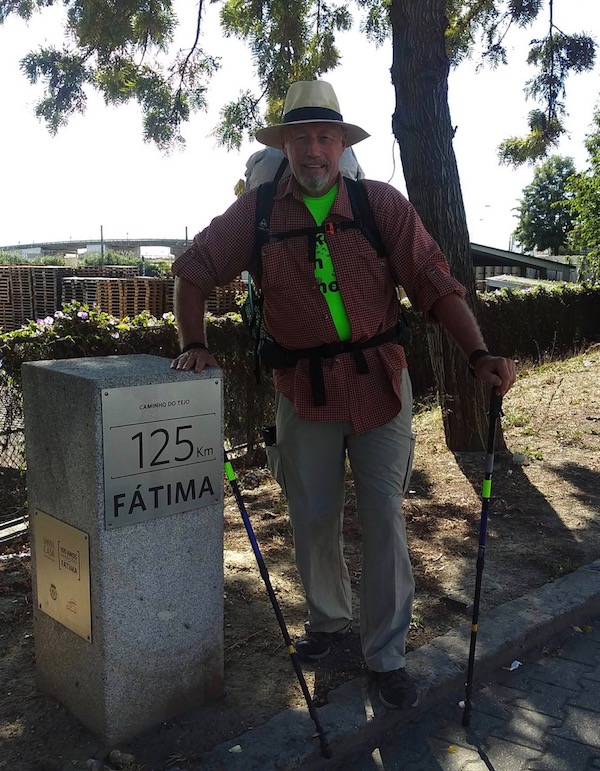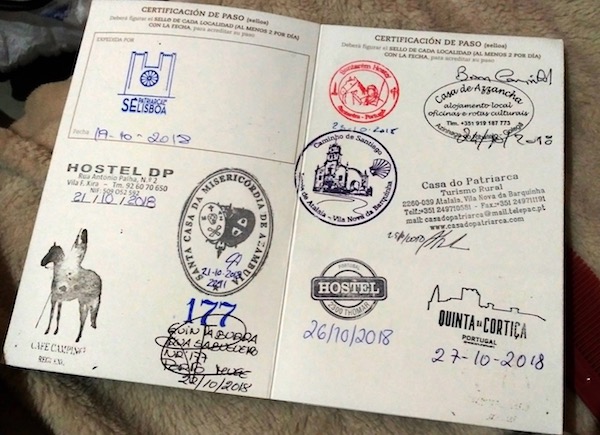Since the time of the Crusades, people have walked the Camino de Santiago (The Way of St. James), a large network of ancient pilgrim routes that stretches across Europe and ends at the tomb of St. James in Santiago de Compostela, in northwest Spain. In 2017, more than 40,000 people undertook the pilgrimage for a variety of religious, spiritual or personal reasons.
For Gorham resident, Ray Ronan, an avid outdoorsman and long distance hiker, the challenge of walking 450 miles in 30 days time, in a country whose language he did not speak, is what drew him in. Ronan said, “To paraphrase Ralph Waldo Emerson, for me, it is always about the journey, not the destination.”
Ronan chose to walk the Central Way which is the main historic route from Lisbon, Portugal to Porto to Tui and finally to Santiago de Compostela in Spain. Only a small number of pilgrims start in Lisbon, because it adds 300 miles to the trip, taking hikers through some less than scenic urban/ industrial/farm landscapes. Most prefer the shorter route beginning in Porto or Tui.

Ronan said, “It’s hard walking, but I am glad I started in Lisbon. I enjoyed the challenge of taking the ‘road less travelled’.” For that same reason, his trip was planned for the off-season, in the fall, to avoid large numbers of pilgrims who hike in the spring. Ronan was fortunate to meet a hiker from California and the two of them hiked much of The Way together.
According to guide books, walking the Camino, or The Way, is not rigorous hiking in terms of elevation changes, but there are plenty of ups and downs. Most of the stages are on good paths, paved roads or even 2000 year old Roman cobbled roads. Ronan said, “Bamboo and eucalyptus forests, and olive groves were a pleasure on the feet as were a few dirt roads that were easier than walking the pavement.”
Ronan, who walked between 10 to 23 miles a day carrying a heavier than recommended 30-35 pound pack, learned that the real challenge is taking care of your feet. He found his Trail Runner shoes inadequate because you are walking on hard surfaces a lot of the time. Gel inserts gave some relief as did a balm on his swollen feet in the evenings. He recommends a shoe with thick, cushioned soles and good cushion socks. He also said that rain gear is a must as well as a hat, bandanas, and hiking poles.
Ronan loved Spain and Portugal and thought the people were very generous and willing to help those hiking. All along The Way the locals leave small gifts of water and fruit which are much appreciated by the hikers. He found the belief that the Camino will provide and that things will work out for the best was true.
People were patient and very helpful with directions, too. It is easy to miss the signs marking The Way, especially if you are starting in the dark, before sunrise, as Ronan typically did. Signage could also be easily missed in small towns and cities due to visual pollution and traffic. He added, “Language could be a humorous challenge, with wild gestures and bits and pieces of words in French, Spanish, English and Portuguese winning the day. I had a conversation with a Korean man who saved me from getting lost.” Ronan also loved trying food at various local places and enjoyed the camaraderie of meeting other hikers while staying in hostels.

Maine Connection: The symbol of a Maltese Cross is seen on a mural when entering the city of Tomar, Portugal. The Knights Templar resided here and were charged by the church with protecting the pilgrims on “The Way.” The Maltese Cross was also the symbol carried by the 20th Maine Regiment under Joshua Chamberlain at Gettysburg.
Each pilgrim carries a document called Credencial Del Peregrino which is stamped at hostels, cafes, and many stores or vendors along The Way. At least two stamps per day during the last 100 miles are required in order to receive an official church-issued Compostella, a document that attests, in Latin, that the pilgrim has completed the journey. Your country of origin is read out at a Pilgrims’ Mass the day after you arrive and are certified.
Ronan’s first long distance hike, in 2000, was the 2165 mile Appalachian Trail, which he through hiked on his own, when his Army buddy could not do the trip. He hiked the scenic 192 mile Coast to Coast Trail in northern England in 2007, and America’s oldest, long-distance hiking path, the 272 mile Long Trail, in Vermont in 2013.
“I am in it for the challenge and to get out of my comfort zone. Each hike has its own set of obstacles that you have to work through,” said Ronan.
Ronan loves the outdoors and is an active member of the Maine Appalachian Trail Club. He enjoys working on his assigned stretch of the A.T. in Monson, Maine and helping with other club projects throughout the season.
Ronan was born in Lewiston, Maine to a Navy family who moved around every 18 months or so, mostly in the U.S. Ronan explained that his philosophy comes from the military: if you are comfortable, it may be time to step out and take on some new challenge.

If you would like to read more about his trip, his blog is available at https://portuguesecaminoray.blogspot.com or via email at walkinhome1@yahoo.com.


